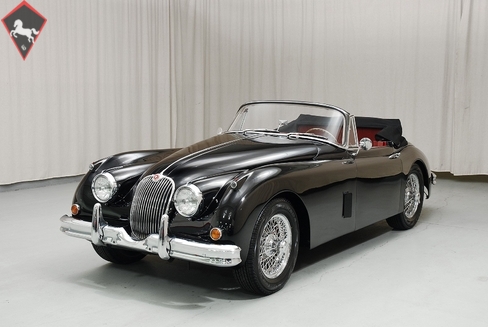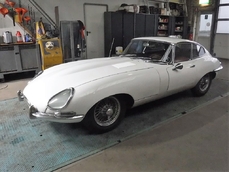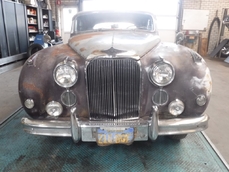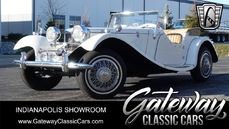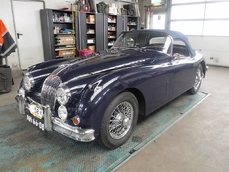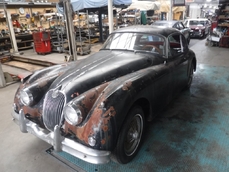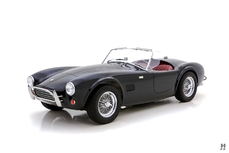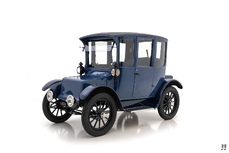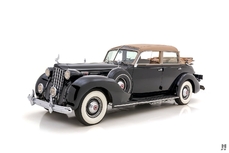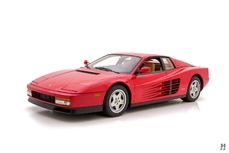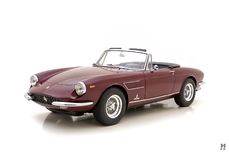Jaguar Other 1960
General description :
The XK-series put Jaguar on the map as a legitimate sports car maker, one that was capable of producing cars that could match the performance and desirability of machines often costing 3 times as much. The evolution of the XK120, XK140 and XK150 saw subtle improvements to braking, handling, and comfort with each subsequent generation. While the XK140 was largely an evolutionary model, the most drastic changes came with the introduction of the XK150 for 1957. The deep, sweeping curves of the XK120 were gone, replaced with a taller and wider body that allowed for more cockpit room, and a one-piece curved windscreen that was in keeping with modern standards. The slab-sided styling of the XK150 was somewhat less sexy than the 120/140, but it still bore a family resemblance and maintained a certain charm of its own.
Mechanically, the XK150 was similar to the 140 it replaced but added 4-wheel disc brakes and other refinements for improved comfort and drivability. The 3.4 liter XK150 was slower than its predecessor thanks to the heavier body and interior. Jaguar soon rectified the performance deficit in 1958 when they introduced the 3.8L engine, giving the XK150 a welcome boost in power, to 250hp in standard trim or 265hp in “S” trim. Suddenly the XK150 found itself fighting for supremacy with the best sports cars on the market. Very few 3.8L drophead coupes were built making this among the most desirable models of the range.
This spectacular XK150 began as a very solid original example that was in need of restoration. In the process, it was substantially but tastefully modified with the goal of creating one of the best driving XK150s in existence. In addition to a show quality finish with exceptional gaps and bodywork, this XK150 has been further enhanced to make it reliable, fast and easy to handle. Clever engineering has been used throughout this XK150 to make maintain a period correct look, but greatly improve performance. Most notably, the Bill Terry-built, matching numbers 3.8L engine now features a custom fuel injection system. This bespoke system uses Bosch injectors hidden in the original intake manifold, and utilizing the butterfly throttles of the S.U. carburetors for air, making the system nearly invisible to the casual onlooker. Fuel management is handled by a Simple Digital Systems ECU. The original 4-speed overdrive Moss gearbox has been replaced with a modern 5-speed and uprated clutch, though the original numbers matching box is included. Air conditioning is seamlessly integrated into the custom dash, and the condenser is mounted discreetly in the rear of the car, a hot rod trick that keeps the radiator clear and the engine bay tidy. Under hood heat is managed by a custom designed system that extracts hot air through hidden pumps and dumps it out through vents in the front fenders. Other significant upgrades include; variable electric power steering, an alloy radiator, and a modern alternator. Inside, you find more tasteful and exquisitely crafted upgrades. Series 1 E-Type coupe seats have been modified to better fit the XK150 and bolstered with high-density gel inserts. They are upholstered in gorgeous burgundy leather. The burl walnut dash adapted from an XK140 adds an element of warmth to the cabin and a fantastic wood-rimmed Moto-Lita wheel awaits your commands. While the modifications and improvements take this car out of the concours realm, all work has been done a concours-level of quality. This XK150 is beautiful enough to show but ultimately this is a car built for fast, reliable and comfortable touring.
http://hymanltd.com/vehicles/5300-1960-jaguar-xk-150-drophead-coupe/
1960 Jaguar Other is listed sold on ClassicDigest in St. Louis by Mark Hyman for $187500.
Car Facts
Car type : Car Make : Jaguar Model : Other Engine size : 0.0 Model Year : 1960 Sub type : Coupé Location : Missouri Vehicle Registration : Normal
Sold
Seller Information
Sold
People who viewed this Jaguar Other also viewed similar Jaguar listed at ClassicDigest
Other cars listed for sale by this dealer
About Jaguar
Ah, the story of Jaguar, from its early days as the SS Cars Ltd. to its pinnacle with the D-type, and the street-going evolution in the form of the iconic E-type. There's something quintessentially British about this tale, and I'll narrate it as a British journalist might.In the Beginnings:
Our journey into the world of Jaguar begins in the 1930s, when a company known as SS Cars Ltd. emerged. Despite the unfortunate coincidence of their initials with the rising political tensions in Europe, they started producing stylish and performance-oriented cars. The SS 100, introduced in 1936, was a symbol of elegance and speed, setting the stage for what would become Jaguar.
The Birth of Jaguar:
As the shadows of World War II loomed, SS Cars Ltd. wisely decided to disassociate themselves from the SS initials. Thus, in 1945, they officially became Jaguar Cars Ltd., a name that would soon be synonymous with British luxury and performance.
The XK Series:
Jaguar's post-war era brought us the XK 120, a true sensation in 1948. With its sleek design and a powerful 3.4-liter inline-six engine, it became the world's fastest production car. The XK 120 was the blueprint for what lay ahead – Jaguars that blended style with speed in a uniquely British fashion.
The D-type Dominance:
Then came the D-type, a true racing legend. Introduced in 1954, it won Le Mans three times in the 1950s, showcasing Jaguar's engineering prowess. With its innovative monocoque construction and the iconic fin at the back, the D-type was the apex of Jaguar's motorsport success.
The E-type Emergence:
But the true turning point arrived in 1961 with the introduction of the E-type, often described by Enzo Ferrari as "the most beautiful car ever made." Its long bonnet, curvaceous body, and a 3.8-liter engine delivering exhilarating performance made it an instant classic. The E-type was not just a car; it was a work of art on wheels, and it could hit 150 mph on the road.
Street and Racing Success:
The E-type's beauty was matched by its capability on the track. The lightweight E-types were particularly successful in various racing events, cementing Jaguar's reputation as a force to be reckoned with in motorsport.
The Age of Refinement:
As we delve deeper into the Jaguar story, we find that the 1950s and 1960s were an age of refinement and expansion. Alongside the magnificent D-type and the E-type's iconic emergence, Jaguar introduced models that further solidified its reputation for luxury and performance.
The MK2:
In the late 1950s, Jaguar unveiled the MK2, a sports sedan that combined elegance with power. This sleek four-door saloon was a favorite of bank robbers and law enforcement alike, thanks to its exceptional speed and handling. The MK2 was a symbol of Jaguar's ability to blend sophistication with performance and had a successful racing career as well.
The XJ6:
Fast forward to 1968, and Jaguar launched a car that would define luxury saloons for decades to come – the XJ6. It was a masterpiece of engineering and design, featuring a smooth inline-six engine, independent rear suspension, and a spacious, beautifully appointed interior. The XJ6 was a symbol of British elegance and provided a ride so smooth that it seemed to glide over the road. It became the flagship model for Jaguar and set the standard for luxury saloons, showcasing a level of refinement that left competitors in awe.
The Blend of Classic and Modern:
While the MK2 and XJ6 represented the evolution of Jaguar's saloon cars, they maintained the brand's commitment to performance and luxury. These cars didn't just belong on the racetrack; they were equally at home cruising down the grand boulevards or gliding through the English countryside.
The Challenges of Change:
However, as the 1970s arrived, Jaguar, like many British automakers, faced financial challenges and changes in ownership. The British Leyland era brought both opportunities and struggles, as the brand navigated through various mergers and transitions.
Nevertheless, the legacy of the MK2 and XJ6, along with the D-type and E-type, continues to define Jaguar as a manufacturer that combines timeless elegance with a spirit of performance. These classic models, whether driven on winding roads or parked as collectors' treasures, serve as a testament to Jaguar's enduring presence in the world of automotive excellence.
The Jaguar story, from its early days as SS Cars Ltd. to the creation of automotive icons like the E-type, MK2, and XJ6, is a journey that reflects the very essence of British motoring – a blend of luxury, power, and style that continues to captivate enthusiasts and connoisseurs alike.
